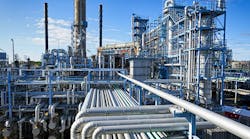Asset performance occurs at many levels—from macro-level optimization of facilities to individual processes and pieces of equipment, including the individual sensors and actuators used to control the process. Many automation professionals associate asset management with the lowest level—keeping track of individual field device quantities, configuration, calibrations and related work orders.
Most field devices installed in today’s facilities include some form of digital communication, and can communicate more information than the process variable to support this lowest level of asset management. Communication devices use some form of onboard diagnostics, such as heuristic rules and pattern recognition, to determine status. Device status, which is analogous to a common trouble alarm for the device, is one of the first information pieces to consider sharing. If device status is communicated to support NE 107, it classifies the status as one of four broad categories that indicate whether the device is still usable or out of service. This indication immediately informs the operator about the urgency for action and potential impact to closed-loop control.
ISA-108 is working with IEC SC65E WG10 to develop Intelligent Device Management standards on procedures and best practices to allow intelligent devices to improve asset utilization and effectiveness at this lowest level, which is the foundation for other asset operations including basic regulatory control.
Despite being fundamental to the control process itself, the search for much larger returns focuses on large equipment, particularly rotating equipment such as pumps and compressors. These devices consume significant power, have many parts that can fail, and can cause unscheduled outages that impact the processes to which they’re connected.
Artificial intelligence (AI) and associated pattern recognition tools can identify the key inputs used by lower-level diagnostic models, and then work in real-time to improve performance management by providing predictive, diagnostic and forecasting analytics. They work together to detect emerging issues, identify causes, and indicate required timeframes for action. These models require maintenance to accurately account for changes in equipment, including new process conditions such as start-up, shutdown, start-of-run versus end-of run, and changes in the process (feed, blends, etc.)
If the objective is to optimize performance of larger, facility-level assets, external factors impacting performance such as cost of power and customer demand must be incorporated into the model.
Asset performance models are developed using a wide range of tools and inputs. Understanding the relevance of the model, boundary conditions and principles of data science help identify relevant and irrelevant data that are keys to success. These include digital twins, which when fully implemented, can use relevant process data such as failures and analysis of root causes. They can be used as inputs to improve and refine the model.
Most larger asset performance models can be complex, so they’re run “offline” and periodically, such as once per hour, once per day or even only on-demand.
Other asset performance models are meant to be used more like optimization routines for a facility or process, which means they’ll run much more quickly and with fewer computing resources. If used this way, the models can be simple enough to run in real-time to provide guidance to operators and help optimize the process.
Multiple suppliers of predictive asset management services claim performance improvements of 2% to 6% increases in availability, 10% to 40% reduction in reactive maintenance, and a 5% to 10% reduction in inventory costs. Similar improvements of up to 30% can be achieved by applying these tools in an asset utilization/capacity.
Asset performance management is about more than field devices. Though the information provided by sensors and actuator diagnostic tools are important inputs to the ability to control the process, applying tools such as AI and resultant models to make intelligent decisions about the process at all levels has proven benefits.




